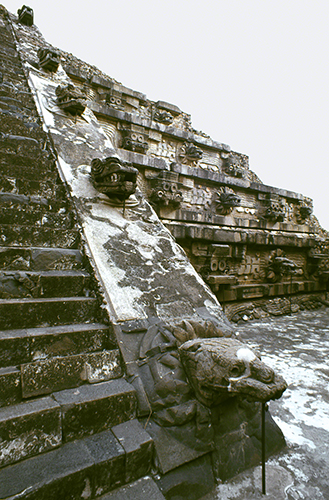Hispanic Heritage Month: Teotihuacán
My look at ancient Mexico continues for Hispanic Heritage Month. Teotihuacán, 30 miles north of Mexico City, was by far the largest and most sophisticated city in ancient Mesoamerica, with cultural and artistic influences that far outstripped other Mesoamerican political entities. At its height during the Classic Period (ca. 250–900 CE), it is thought to have had a population of 150,000 to 200,000 people, and the city covered an area of 8 square miles (12.87 kilometers).
 |
| Teotihuacán, Temple of Quetzalcoatl, ca. 150–200 CE. Image © 2019 Davis Art Images. (8S-8120) |
The origins of the people who built Teotihuacán are unclear to this day, but the ceramics, sculpture, and architecture of the civilization of the city had a wide-ranging impact on all of the surrounding cultures. According to carbon-dating, the earliest structures in Teotihuacán date to 200 BCE, although the major phases of the existing city configuration date from the late Pre-Classic Period (ca. 200 BCE–250 CE). It is theorized that the valley itself was first settled as far back as 600 BCE.
The city is laid out in a grid where the ceremonial structures were built first. In typical Mesoamerican style, cities were built in symmetrical fashion, with major buildings built on platforms surrounded by plazas and ceremonial courts. A great avenue—the Avenue of the Dead—bisects the city on a north/south axis, running for almost 3 miles (5 kilometers), at some points 150 feet (45 meters) wide. The city was by and large supported by the generally agricultural population, ruled by an elite priestly class. The farmers of Teotihuacán practiced sophisticated terraced farming with irrigation systems channeled from natural springs.
The Temple of the Feathered Serpent is located at the southern end of the Avenue of the Dead. It is within the Citadel complex, a structure with high walls and a large courtyard surrounding the temples. There are several other monumental structures within the Citadel, including mansions (probably for elite) and platforms. The temple is named for the creation deity Quetzalcoatl (from the native Nahuatl language, meaning feathered serpent), a deity worshipped by many other Mesoamerican cultures. This temple is one of the earliest in Mexico dedicated to the deity.
The Temple of the Feathered Serpent is constructed in the talud-tablero style. It is a six-level pyramid with alternating, inward-slanting surfaces and flat masonry platforms parallel to the ground. Each level is decorated with projecting Quetzalcoatl (feathered serpent) heads alternating with the mask-like Tlaloc (storm god) heads. An alternate theory to the temple's dedication is that the serpent heads represent the Teotihuacán "fire storm" god wearing the symbolic war headdress. Either way, these are some of the earliest representations of the feathered snake.
Check back Friday for my next post in the Hispanic Heritage Month series about Maya culture.


Comments